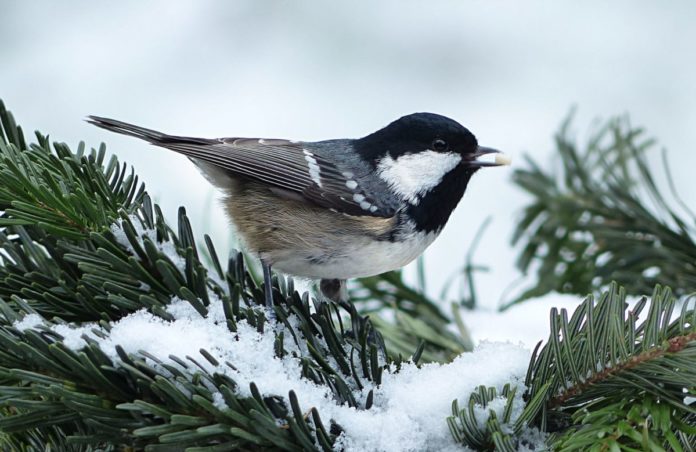Backyards and home gardens are the territories of many wild birds. Great tits, house sparrows, robins, blackbirds and many others regularly come to our gardens (and balconies) searching for food and refuge. We can help wild birds finding some comfort food in winter and enjoy their visits.
Why so many birds visit our home gardens (and balconies)?
The two main reasons are shelter and food. Cities are warmer than the surrounding countryside, which is why many birds choose to move to urban areas during winter. The vegetation in our gardens can provide wild birds with adequate shelter and overnight places, especially in shrubs and trees.
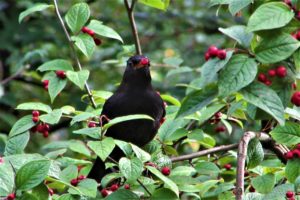
During winter days, birds need to eat more during the daytime to survive the long cold winter nights without starving. There is, however, less naturally occurring food, so birds turn to our gardens, yards and streets. You may see them scouring for some discarded leftover but also feeding on winter berries, foraging for seeds in the soil, and pecking our the occasional bug or worm. And, of course, visiting the bird feeders many people place in their garden or balcony.
Giving wild birds a helping hand
To help wild birds overcome the icy-cold winter we can set up bird feeders in our yards and gardens. Even if you only have a balcony, you can still do this and be visited by great-tits, blue-tits, sparrows and many others.

It’s really fun to see wild birds right from your own window, in your own home! It’s exciting to anticipate which species will show up this day. And watching birds come and go is a quite relaxing way to start your day or have a break from your work-from-home.
Another way we can help is to set up a nest box outside. This season (end of autumn and winter) is the right time to put them up. It gives future tenants the time to visit, get to know and decide if they want to settle there before their breeding season begins (typically in spring).
Feeding the hungry bird – bird feeder basics
It’s possible to acquire standard bird feeders in almost any garden centre and pet-shop (also online). There is a wide variety of models, sizes, types, etc., so you are sure to find one suited for your garden/balcony/window and personal taste*.
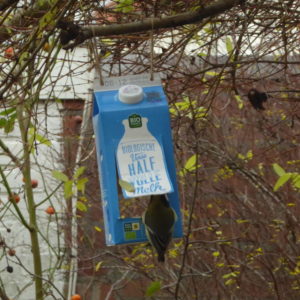
You can also make your own bird feeder. Two quick examples: 1) use a 2-litre milk or juice package with a square cut out in one of the sides and stock it with seeds; 2) mix peanut butter with bird seeds and then smear a pine cone with the mixture! It either case, then use string or wire to hang it.
You can stock up your birdfeeders with wild bird seed-mixes, single type seeds (tip: sunflower seeds are a favourite!) or unsalted peanuts. These are all easy to get in garden centres, pet-shops and even supermarkets.
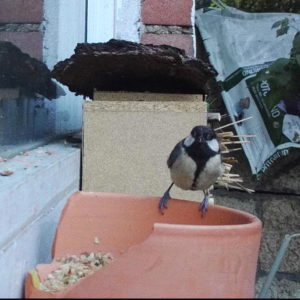
Or you can simply place a wide cup or bowl in a sheltered place (so it doesn’t get rain) with some bird food. Apart from seeds and nuts, you can complement with bread crumbs (moderately), cake crumbs, raisins, and fruit leftover.
However, DO NOT only provide bread or cake to birds. Although tasty, bread has low nutritional value, and it’s NOT a proper food to regularly feed wild garden birds (the same applies to ducks, by the way).
Place your birdfeeder away from predators’ reach – namely roaming house cats – and where they can see incoming threats. Regularly clean your birdfeeders, especially after rain or snowfall: just like humans, stale and mouldy food is bad for birds.
A place to nest – about nest boxes
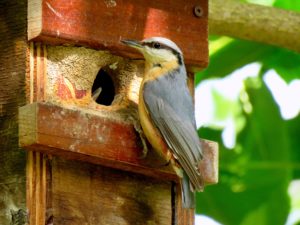
Nest boxes are used by wild birds to nest, breed, and raise their chicks. They are an alternative to natural breeding sites, usually holes and cavities in (old) trees, walls and rocks.
Most nest boxes are suited for small birds, such a great- and blue-tits, sparrows, nuthatches, starlings, etc. The different nest box’s shapes and entrance sizes are suited for different bird species*. Others, with wider openings, are made for robins and blackbirds. There are even larger nest boxes, made for owls and kestrels!

The Vogelbescherming (the Dutch bird protection NGO) webshop has many different types to choose from (Please note: I am in no way affiliated with them). Buying from them assures that the nest box we are getting is appropriate for wild birds; plus we are contributing to a nature conservation organization.
Place the regular nest boxes at least 2 meters high, well secured to a tree trunk or a wall. Nest boxes for robins and blackbirds should be placed inside a dense shrub or ivy. In any of the cases, make sure the location it out of a cat’s reach: pay attention it is far enough from fences, ledges or other places a cat could use either to reach the next box of to prepare for an ambush (yes, house cats also do that).
Birds are now visiting my garden! What species are they?
Next time, I’ll introduce you to some of our common garden birds and how you can recognize them; and tell you about the upcoming national garden bird count (Nationale Tuinvogeltelling).
* if you need some tips in choosing the right birdfeeder or nest box for your home, you can contact me via Facebook or email (nuno @ wild-eindhoven.com). I’ll help you decide the best for you!
For Eindhoven News: Nuno Curado
A wildlife ecologist, fascinated with urban nature: the wild animals and plants that live with us in the cities! He is the person behind Wild Eindhoven: a one-person company on a mission to help everyone discover nature in the city, from city parks to our home balconies!


